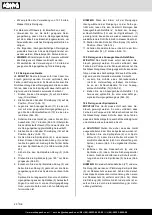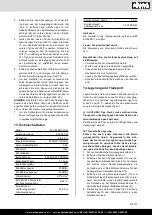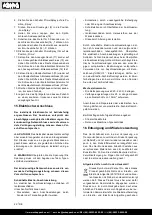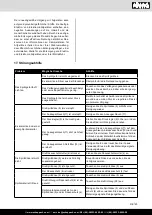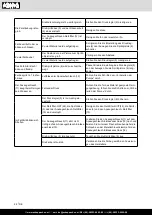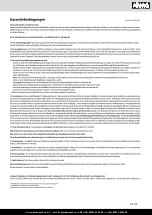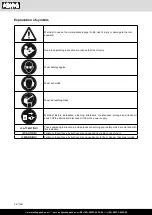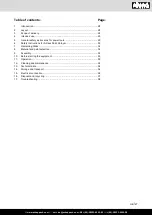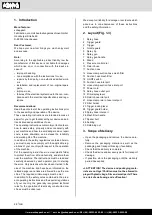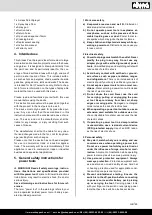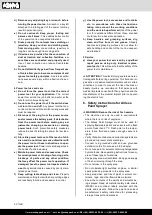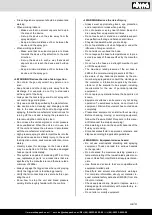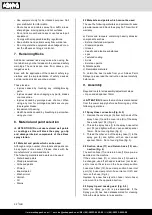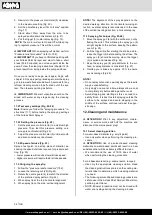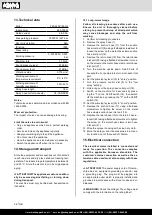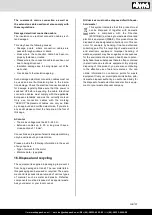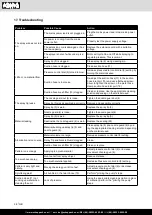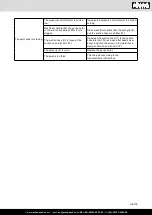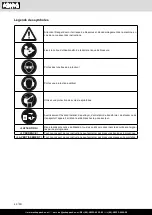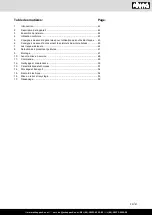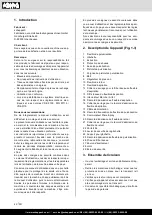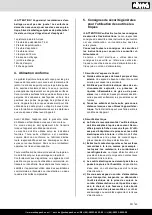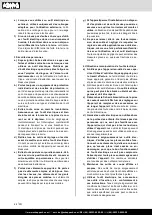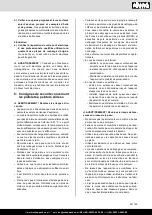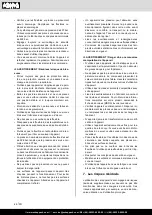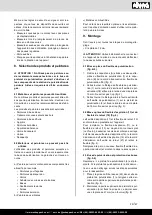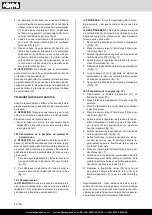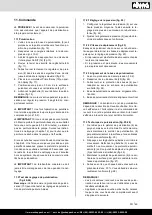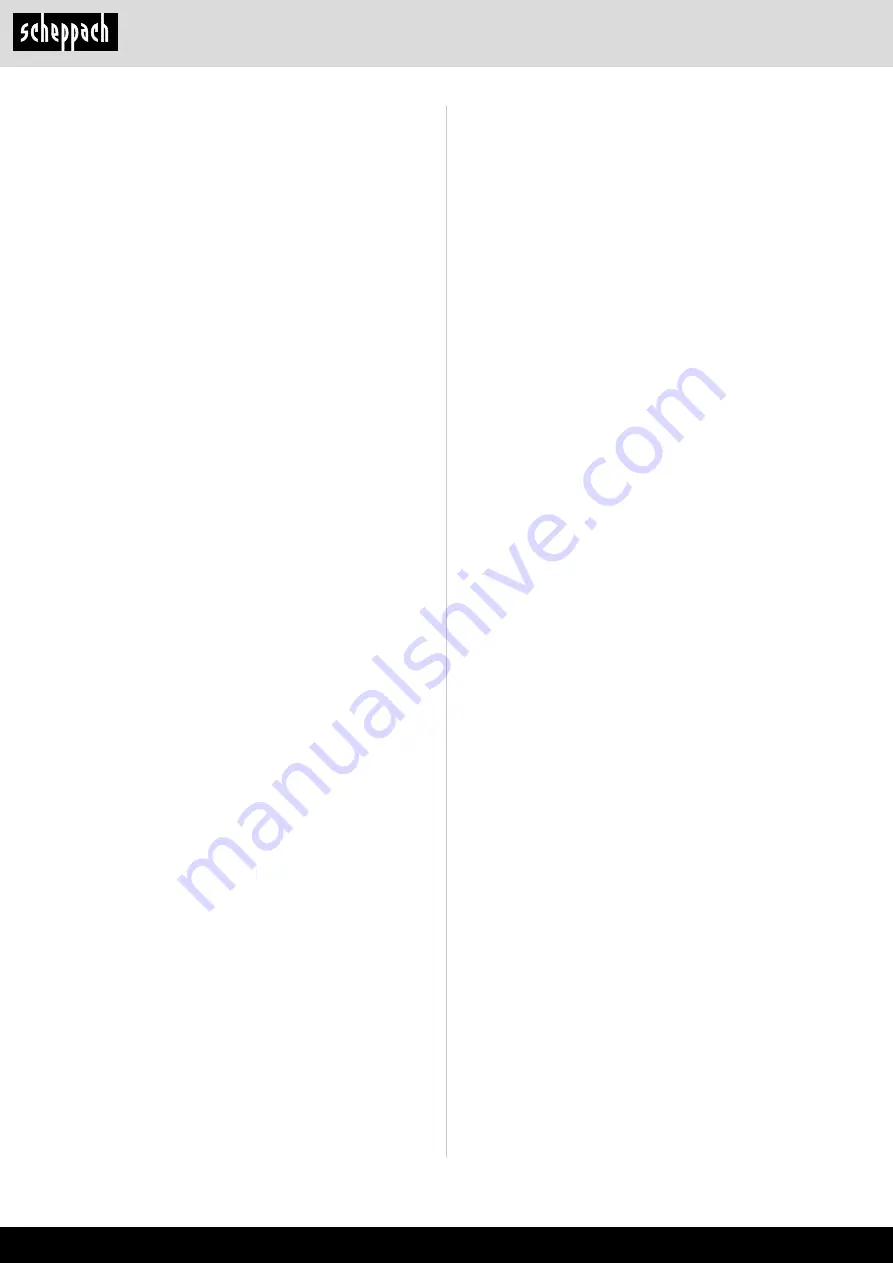
www.scheppach.com /
service@scheppach.com /
+(49)-08223-4002-99 /
+(49)-08223-4002-58
34 | GB
NOTE!
The alignment of the spray depends on the
desired working direction. For horizontal working di-
rection, a vertical spray is recommended. In the case
of the vertical working direction, a horizontal spray.
11.3 Spraying Technique (Fig. 25-28)
1. Move the spray gun (6) with the entire arm, not by
flexing the wrist. This will keep the spray gun (6)
at right angles to the surface, keeping the pattern
even (Fig. 25).
2. Pull the trigger (3) after starting the stroke, and re-
lease the trigger (3) before ending the stroke. The
spray gun (6) should be moving, when the trigger
(3) is pulled and released (Fig. 26).
3. Keep the spray gun (6) perpendicular to the sur-
face, so spray distance is consistent (Fig. 27).
4. Overlap your strokes by approx. 30% to ensure
even coverage (Fig.28).
NOTE!
• Do not spray outdoors on a windy day as the results
may be unsatisfactory.
• Only apply one coat at a time, always allow a coat
to completely dry before adding another coat.
• Avoid stopping and starting as this can lead to a
patchy finish. It is best to start spraying outside the
surface to be sprayed and avoid stopping in the
middle of the surface, continue just past the oppo-
site edge.
12. Cleaning and maintenance
m
ATTENTION!
Prior to any adjustment, mainte-
nance or service work switch off the machine and
disconnect the mains power plug!
12.1 Select cleaning solution
For water-based material (e.g. acrylic paint):
• Use only water when performing the cleaning pro-
cedure.
m
ATTENTION!
Use of a solvent-based cleaning
materials on water-based paints will result in a new
substance that will be extremely difficult to clean.
• We recommend the use of 10-15 litres of water
when performing the cleaning procedure.
For oil-based material (e.g. enamel paint , lacquer):
• Use only the appropriate cleaning solution. Read
the cleaning instructions printed on the coating ma-
terial`s label to determine which cleaning material
you need.
• The following solvent-based cleaning products are
safe to use in the Airless Paint Sprayer: Mineral tur-
pentine, paint thinner
• NOTE: Mineral turpentine must not be mixed with
water at any stage during the cleaning process.
5. Slowly turn the pressure control dial (9) clockwise
to the maximum setting (Fig. 20)
6. Set the prime7spray lever (19) to "spray" position
(Fig. 17)
7. Stand about 30cm away from the area to be
sprayed and maintain this distance (Fig. 21).
8. Pull the trigger (3) to start spraying (Fig. 15).
NOTE:
The motor will cycle On and Off while spray
-
ing to regulate pressure. This will be normal.
m
IMPORTANT!
When spraying is finished, perform
"Pressure relief procedure" (refer to 10.2).
m
IMPORTANT!
If you have not finished painting with
your Airless Paint Sprayer and want to take a short
break (30-60 minutes), do not leave paint inside the
pump. Follow the cleaning instructions (chapter 12) to
prevent paint from dying inside the pump and hose.
Once you`re ready to begin work again, begin with
chapter 9. Once properly primed again, aim the spray
gun into a waste bucket and allow 30 seconds for any
leftover cleaning solution to be flushed out of the sys
-
tem. Then resume painting as before.
m
IMPORTANT!
Mineral Turpentine should not be
mixed with water at any stage during the cleaning
process.
11.2 Test spray settings (Fig. 22-24)
Note:
Ensure you follow the "spraying procedure" in-
structions (11.1) before testing the spraying settings
of the Airless Paint Sprayer.
11.2.1 Setting the pressure (Fig. 22)
1. Set the pressure control dial (9) to a medium high
pressure. Then test this pressure setting on a
scrap piece of material (Fig. 22).
2. Adjust the pressure control dial (9) until a smooth
and even consistency is achieved.
11.2.2 Speed of stroke (Fig. 23)
Spray a test patch on a scrap piece of material, as-
sessing the speed of stroke required for pressure set-
ting. (Fig. 23)
• Lower pressure will require slower stroke speed.
• Higher pressure will require faster stroke speeds.
11.2.3 Aligning the spray tip
1. Follow the "pressure relief procedure" (10.2).
2. Loosen the retaining nut (29) (Fig 24).
3. Rotate the nozzle guard (4) to match the direction
of the preferred spray pattern (Fig. 24).
4. When spray tip at the top: horizontal alignment
5. When spray tip on the side: vertical alignment

